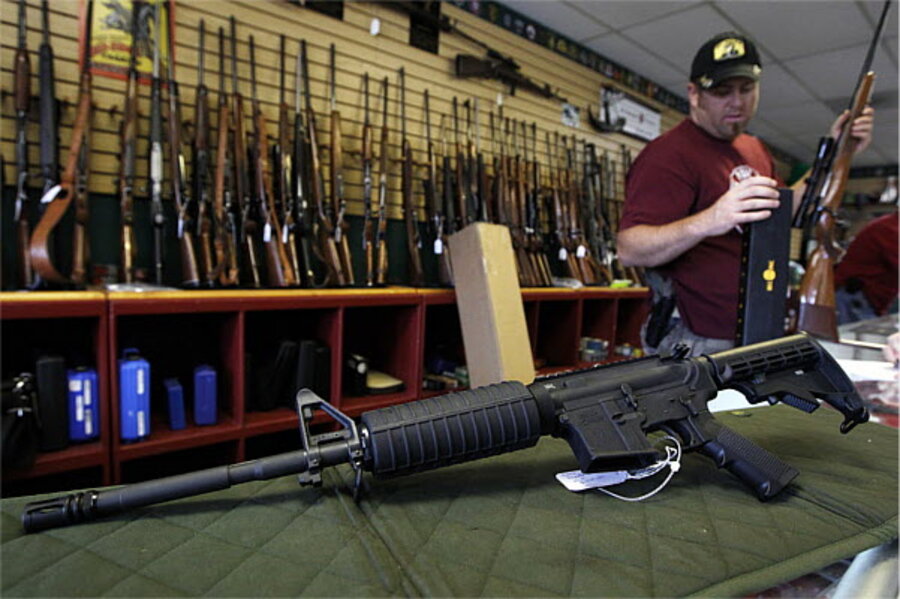Georgia school district mulls over buying assault rifles: Could it be a good idea?
Loading...
| Atlanta
A north Georgia school district is deciding whether to have small assault-weapon armories in its schools to be ready for an attack.
Many Americans, of course, remain deeply disturbed about the prospect of arming school officials, and some studies have shown that armed school guards don’t necessarily de-escalate or prevent school shootings. Yet what would have just a few years ago been a shocking plan to store semiautomatic assault carbines in the front office is now being considered seriously.
“These incidents constitute a minuscule fraction of overall homicides, but they horrify us more because we have this feeling that this can happen anywhere for no particular reason, and where no recognized set of precautions will stop it,” says law professor Bob Cottrol, a gun-policy expert at George Washington University. “So everybody is looking around for potential solutions.”
The move by Gainesville City Schools – a small system near Georgia’s Lake Lanier, in the Appalachian foothills – is a direct result of last year’s massacre at Sandy Hook Elementary School in Newtown, Conn., where 20 children and six staff members died at the hands of a troubled and heavily armed young man who broke into the school and began shooting.
In August, another young man allegedly broke into a charter school in Decatur, Ga., and fired several shots before a quick-thinking and empathetic bookkeeper named Antoinette Tuff talked him into surrendering.
The plan in Gainesville would be for the district to buy two Colt 6920 M4 carbines and keep them in locked safes equipped with fingerprint locks, so only one person – the school resource officer – could have access. The weapons would be stored in the resource officer’s car trunk when no students are at school.
The police and school system would split the $6,000 cost for each rifle.
The Gainesville rifle plan is part of a debate happening in school districts across the United States. So far in 2013, seven states have passed laws allowing teachers to have guns at school. One of them, Arkansas, has already begun to arm willing teachers.
Opponents of such plans point to the fact that 27 percent of US schools already have armed guards, and there’s no discernible difference in homicide statistics between schools with armed guards and those without. Critics also cite increased liability as a major sticking point, with the potential of lawsuits against school districts even from families of actual or would-be school shooters, according to a study published in the American Journal of Criminal Justice earlier this year.
Arming schools, critics further argue, adds a disproportionate amount of risk for a statistically rare ordeal. There’s about 1 homicide for every 2.7 million students in the US each year.
The differing responses to Sandy Hook boil down to two distinct threat prevention philosophies: shooter prevention and damage control, experts say.
“If schools put more focus on early detection of warning signs and [the creation of] threat assessment teams, that would be doing more to prevent school shootings than putting more guns in schools. [The latter is] not prevention, that’s emergency response,” says Dr. Peter Langman, a psychologist and author of “Why Kids Kill: Inside the Minds of School Shooters.”
But while schools around the country have revisited their emergency plans since Sandy Hook, a recent study by Amy Klinger of Ashland University in Ohio suggests that it’s still easy for “strangers” to get into most school buildings. A team led by Dr. Klinger did vulnerability assessments for a number of school districts, most of which failed the test.
“In the vast majority of the schools we assessed, our professional intruder was easily able to access the building without interference,” Klinger said in a press release.
One reason for the push toward more guns in schools has to do with a key argument in the gun-rights debate – the proclivity for mass shooters to target gun-free zones like schools and theaters, aware that they’re less likely to be shot before they carry out their crime.
“I tend to be on the side that says armed security makes sense for schools,” says Professor Cottrol. “If it doesn’t make sense, then remove them from banks ... not to mention almost every celebrity in this country, including most [national] politicians, who have armed security following them. Let’s remove those guys as well.”








